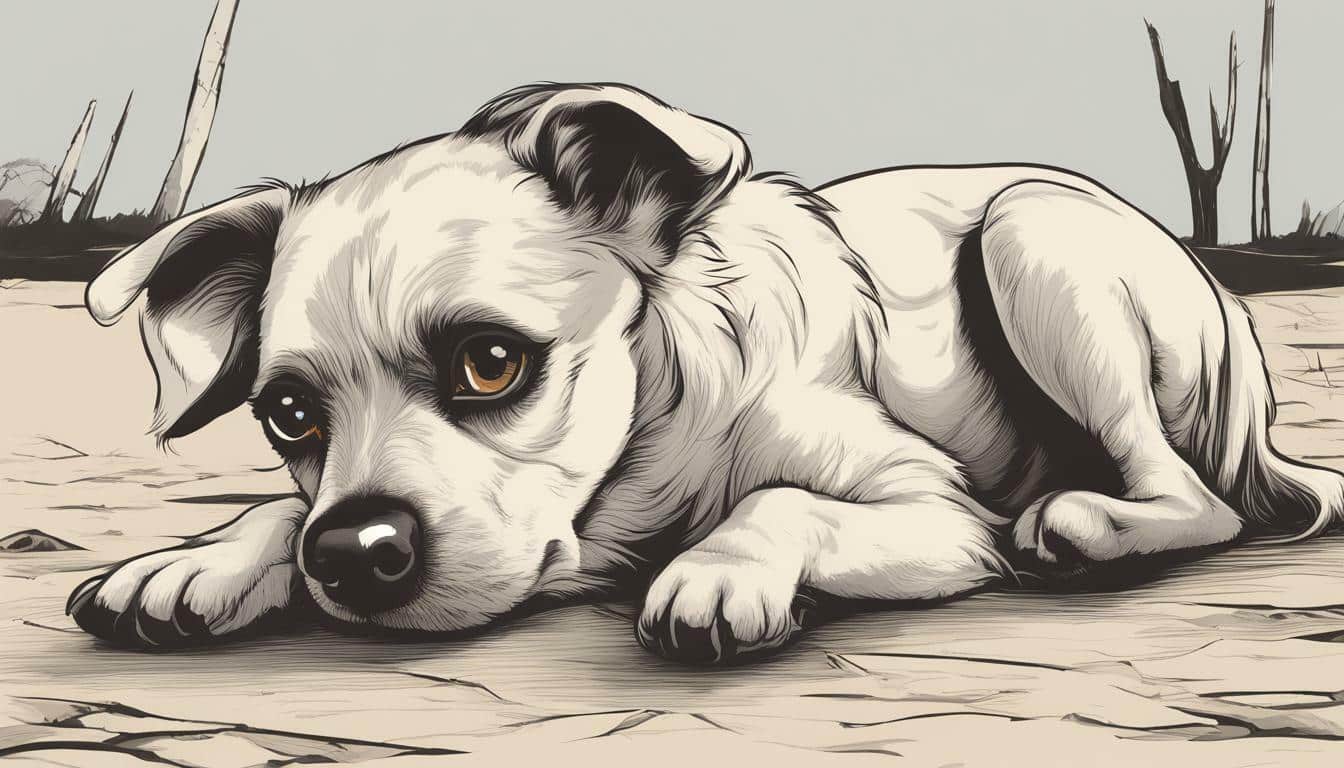Recognizing the Signs of a Distressed Dog: Essential Tips for Dog Owners

Dogs are known for their loyalty, love, and affection towards their owners. As dog owners, it is our responsibility to ensure their well-being, both physically and emotionally. One of the most important aspects of caring for our furry companions is recognizing when they are in distress and taking appropriate measures to address their needs.
Dog distress can manifest in various ways, and it is essential to be aware of the signs to provide prompt assistance. Symptoms of distress in dogs can range from subtle changes in behavior to more visible physical symptoms. Early recognition of these signs can help prevent prolonged distress and promote a healthy and happy life for your dog.
Key Takeaways:
- Recognizing distress signs in dogs is essential for their overall well-being.
- Distress in dogs can manifest in various ways, including physical and behavioral symptoms.
- Early recognition and appropriate intervention can prevent prolonged distress and promote a happy and healthy life for your dog.
Understanding Dog Distress: Causes and Consequences
Dogs, like humans, can experience anxiety and stress, which can manifest in various ways. It’s essential for dog owners to recognize the signs of distress and take appropriate action to alleviate their pet’s discomfort. Anxious dog behavior, stressed dog signs, and canine stress indicators are some common terms associated with dog distress. In this section, we’ll take a closer look at what causes distress in dogs and the potential consequences of prolonged anxiety.
| Causes of Dog Distress | Consequences of Prolonged Distress |
|---|---|
|
|
Anxiety in dogs can be triggered by a range of factors, such as loud noises, unfamiliar surroundings, changes in routine, and crowded spaces. Separation anxiety is also a common cause of distress in dogs. It occurs when dogs become anxious and agitated when left alone, leading to destructive behavior and excessive vocalization. Prolonged distress can have serious consequences on a dog’s physical and mental health, including behavioral issues, physical health problems, and reduced life expectancy.
As responsible dog owners, it’s crucial to recognize these signs of distress and take action to address the root cause of the anxiety. In the following sections, we’ll explore the specific behavioral and physical signs that indicate a dog is in distress, along with strategies for managing and preventing anxiety in dogs.

Behavioral Signs of a Distressed Dog
Dogs communicate through body language, and it is crucial for dog owners to understand the various cues that indicate their pet’s emotional state. When dogs experience fear or stress, they exhibit specific behavioral signs that can help owners recognize distress.
Signs of a fearful dog include trembling, panting, pacing, and avoidance of eye contact. The dog’s posture may also appear tense, with its ears flattened or tail tucked between the legs. Dogs may also exhibit excessive vocalization or destructive behavior when experiencing distress.
It is essential to observe the dog’s overall body language, as multiple cues may indicate anxiety or stress. For example, a dog that is panting while also avoiding eye contact may be experiencing distress. Similarly, a dog that is excessively vocalizing while also pacing could be displaying signs of distress.

Understanding the behavioral signs of a distressed dog is crucial for prompt recognition and appropriate intervention. Owners who recognize these signs should take steps to minimize the environmental stressors and provide comfort to their pets.
Physical Signs of Dog Distress
Recognizing physical signs of distress in dogs is crucial for their well-being. While some signs may be subtle, others are more apparent and should be taken seriously. Here are some common physical signs that dogs exhibit when they are distressed:
| Sign | Description |
|---|---|
| Increased heart rate | When dogs are stressed, their heart rate increases, and they may begin to breathe faster as well. This can be a sign of a more serious issue and should be evaluated by a veterinarian. |
| Dilated pupils | Dogs in distress often have dilated pupils, which means their pupils are larger than usual. This can be a sign of fear, anxiety, or stress. |
| Excessive drooling | Dogs may drool excessively when they are stressed or anxious. This is often a sign of nausea or other physical discomfort. |
| Gastrointestinal issues | Stress can cause dogs to experience digestive problems such as diarrhea or constipation. This can be a sign of underlying health issues and should be evaluated by a veterinarian. |
If you notice any of these physical signs in your dog, it is essential to take action right away. These symptoms can quickly escalate into more severe health problems. Seek veterinary attention if necessary, and never hesitate to ask for help if you are unsure how to best care for your dog.

Vocalization and Communication in Distressed Dogs
Dogs communicate their emotions through various forms of vocalization and body language. When dogs are distressed, they may display certain types of vocalizations that are different from their usual barks and whines.
One of the most common vocalizations of a distressed dog is excessive barking. Dogs may bark persistently when they feel threatened or scared. It is important to recognize the difference between normal barking and excessive barking that signals distress.
Other vocalizations that dogs may exhibit when distressed are whining, growling, and howling. These are all potential indicators of anxiety and stress in dogs and should not be ignored.
In addition to vocal cues, dogs also communicate their emotions through body language. For example, a dog may tuck its tail between its legs, cower or hide, or avoid eye contact when it is distressed. These behavioral cues can indicate fear, stress, or anxiety.
It is essential for dog owners to observe and interpret these communication signals to understand their pet’s emotional state. Recognizing distress signals early on can prevent further escalation of stress and anxiety in dogs.

Environmental Triggers of Dog Distress
Recognizing the signs of distress in dogs is crucial for pet owners to provide proper care and support for their furry friends. Environmental factors can play a significant role in triggering distress in dogs. Loud noises such as thunderstorms and fireworks, unfamiliar surroundings, changes in routine, and crowded spaces are common triggers that can lead to anxiety and stress in dogs.
Dogs have sensitive hearing, and loud noises such as fireworks and thunderstorms can cause distress. Fear of loud noises can cause dogs to exhibit behaviors such as shaking, panting, and excessive barking. Unfamiliar surroundings, such as a new home or boarding facility, can also cause anxiety in dogs. Changes in routine, such as an owner’s absence due to work or travel, can also be a trigger. Being in crowded spaces, such as dog parks or events, can cause dogs to become overwhelmed and anxious.

| Environmental Triggers of Dog Distress | Recognizing Dog Distress |
|---|---|
| – Loud noises | – Shaking |
| – Unfamiliar surroundings | – Panting |
| – Changes in routine | – Excessive barking |
| – Crowded spaces | – Overwhelmed behavior |
To minimize these triggers, it is essential for dog owners to understand their pet’s behavior and personality. Identifying the signs of distress and avoiding triggering situations is one way to create a calming environment. For example, during fireworks or thunderstorms, dogs can be kept in a quiet, secure area with comforting items such as blankets and toys. Socialization and training can also help dogs feel more at ease in different environments. Positive reinforcement training can encourage good behavior and reduce anxiety. Creating a safe and secure space for dogs, such as a designated area for naps and playtime, can also help reduce distress.
Recognizing the signs of distress in dogs and minimizing environmental triggers are critical in promoting their well-being. By taking proactive steps to create a calm and supportive environment for dogs, owners can help their pets live happy, healthy lives.
Preventing and Managing Dog Distress
Recognizing signs of distress in dogs is crucial for every dog owner, but preventing and managing distress is equally important. Here are some tips to help:
- Socialization: Proper socialization at an early age can help dogs develop resilience to stress. Introduce your dog to a variety of people, animals, and environments to build their confidence and adaptability. Training classes are also a great way to socialize your dog.
- Positive reinforcement: Reward-based training methods are essential for creating a positive and trusting relationship with your dog. Avoid using punishment or negative reinforcement, as it can lead to anxiety and stress in dogs.
- Safe and secure space: Provide your dog with a designated safe and secure space where they can retreat to when feeling overwhelmed. This can be a crate, a cozy bed, or a quiet room.
- Consistent routine: Establishing a consistent daily routine can help reduce anxiety in dogs. Stick to a regular feeding, exercise, and sleep schedule to create a sense of stability and predictability for your dog.
- Regular exercise: Exercise is not only important for physical health, but also for mental well-being. Take your dog for daily walks or runs and engage in interactive play to help release excess energy and promote relaxation.
- Calming activities: Calming activities such as massage, aromatherapy, and music can help promote relaxation in dogs. Using pressure wraps or creating a calming environment with pheromone diffusers can also be effective.
- Professional help: Seek professional help from a veterinarian or certified dog behaviorist if your dog is experiencing severe or persistent distress. They can provide expert guidance and support to help manage your dog’s anxiety.
By implementing these preventive measures and management strategies, you can help reduce the risk of distress in your dog and promote their overall well-being.

Seeking Professional Help for Distressed Dogs
Recognizing distress signals in dogs is crucial to their well-being, but sometimes, a pet owner’s efforts may not be enough. In cases of severe or persistent distress, seeking professional help is essential.
A veterinarian or a certified dog behaviorist can diagnose the underlying cause of a dog’s distress and recommend appropriate treatment. They can also provide a safe and supportive environment for dogs who may be at risk of harming themselves or others.
When to Seek Professional Help
If a dog’s distress symptoms persist for more than a few days, become increasingly severe, or interfere with their daily activities, it may be time to seek professional help.
Dogs who exhibit aggressive or destructive behavior, have sudden changes in appetite or activity level, or show signs of physical illness should be seen by a veterinarian immediately.
What to Expect During Professional Help
When seeking professional help for a distressed dog, expect to answer detailed questions about the dog’s behavior, medical history, and living environment. The professional may also observe the dog’s behavior and conduct diagnostic tests to rule out underlying medical issues.
The treatment plan may include medication, behavior modification techniques, or a combination of both. The professional may also provide guidance on how to modify the dog’s living environment to reduce potential triggers of distress.

Remember, seeking professional help is not a sign of failure or weakness. Rather, it is a proactive step towards ensuring the well-being of your furry companion. By working with a professional, you can help your dog overcome distress and lead a happy and healthy life.
Training Techniques for Anxious Dogs
Anxiety is a common problem among dogs, and it can be challenging to manage. Fortunately, there are several training techniques that can help reduce anxiety in dogs. These methods are based on positive reinforcement and aim to change a dog’s response to anxiety-inducing stimuli.
Counter-conditioning
Counter-conditioning is a training technique that involves pairing anxiety-inducing stimuli with a positive experience. For example, if a dog is anxious around strangers, the owner can pair the presence of strangers with a treat or a favorite toy. Over time, the dog will learn to associate strangers with positive experiences, and the anxiety response will decrease.
Desensitization
Desensitization is a gradual process of exposing a dog to anxiety-inducing stimuli in a controlled environment. For example, if a dog is anxious around fireworks, the owner can play a recording of fireworks at a low volume while providing treats and playtime. Over time, the volume can be increased gradually until the dog is comfortable with the sound of fireworks.
Calming Signals
Calming signals are body language cues that dogs use to communicate their emotional state. These signals can be used by owners to help calm an anxious dog. For example, yawning, lip licking, and turning away from a stressful stimuli are all calming signals that can be employed to communicate to a dog that everything is okay.
It is important to note that training techniques for anxious dogs should always be employed with the guidance of a professional dog trainer or behaviorist. These professionals can provide personalized advice and guidance to ensure that the training is effective and safe for the dog.
Natural Remedies for Dog Distress
When dealing with dog anxiety symptoms, natural remedies can be a safe and effective alternative to medication. These remedies can help calm anxious dogs and ease their distress. Here are some natural remedies that can help alleviate dog distress:
Herbal Supplements
Herbal supplements such as chamomile, valerian root, and passionflower can help calm a stressed dog. These supplements can be given as capsules, tinctures, or added to the dog’s food. It is important to consult with a veterinarian before administering any herbal supplements to ensure the safety and proper dosage for your dog.
Pheromone Diffusers
Pheromone diffusers can be effective in promoting relaxation and reducing anxiety in dogs. These diffusers release synthetic versions of calming pheromones that dogs naturally produce, helping to create a sense of security and comfort. They can be particularly useful for dogs with separation anxiety or fear of loud noises.

Aromatherapy
Aromatherapy can also be a helpful natural remedy to soothe a distressed dog. Essential oils such as lavender, chamomile, and bergamot can have calming effects when diffused or applied topically. However, it is important to use caution when using essential oils around dogs as some can be toxic. Always dilute oils and consult with a veterinarian before using them on or around your dog.
These natural remedies can be a great addition to a comprehensive plan for recognizing dog distress and managing dog anxiety symptoms. However, if your dog’s distress persists or becomes severe, it is important to seek professional help from a veterinarian or certified dog behaviorist.
Creating a Calming Routine for Dogs
Establishing a calming routine is a crucial aspect of alleviating distress in dogs. Dogs thrive on structure and consistency, and a predictable routine can help reduce anxiety and promote a sense of security. Here are some tips for creating a calming routine for your dog:
1. Stick to a Daily Schedule
Dogs feel more secure when they know what to expect from their day. Try to establish a consistent daily routine for your dog, including feeding times, exercise, and rest periods. Make sure the routine is realistic and sustainable for your lifestyle, so that you can stick to it long-term.
2. Incorporate Relaxation Exercises
Just like humans, dogs can benefit from relaxation exercises such as deep breathing and muscle relaxation. You can practice these exercises with your dog during quiet times throughout the day, such as before bedtime or after a walk. Encourage your dog to lie down, take deep breaths, and release tension in their muscles.
3. Use Consistent Training Methods
Consistent training methods can help dogs feel more secure and confident. Use positive reinforcement techniques such as treats, praise, and toys to reward good behavior. Avoid punishment or negative reinforcement, which can increase anxiety and stress.

4. Provide a Safe and Secure Space
Dogs need a designated space where they can feel safe and secure. This can be a crate, a bed, or a specific room in your home. Make sure your dog has access to their safe space throughout the day, and encourage them to use it when they need a break or some alone time.
5. Incorporate Mental Stimulation
Mental stimulation can help keep dogs engaged, focused, and mentally healthy. Try incorporating activities such as puzzle toys, interactive games, and training exercises into your dog’s daily routine. Mental stimulation can also help tire out dogs, which can reduce anxiety and promote relaxation.
6. Stay Attentive to Signs of Fear and Anxiety
Even with a consistent routine, dogs may still experience fear and anxiety from time to time. Stay attentive to the signs of distress in dogs, such as trembling, avoidance, and excessive panting. If you notice these signs, adjust your routine accordingly and provide extra comfort and support to your furry companion.
Addressing Separation Anxiety in Dogs
Separation anxiety is a common form of distress in dogs that can be challenging to address. Recognizing the signs of separation anxiety in dogs, such as destructive behavior, excessive barking, and house soiling, is essential in preventing prolonged distress.
To alleviate separation anxiety, dog owners should gradually desensitize their pets to being alone. This can be achieved by increasing the amount of time the dog spends alone, starting with short periods and slowly increasing the duration. Providing interactive toys, crate training, and calming music can also help to soothe and distract the dog during periods of separation.
If separation anxiety persists, seeking professional help from a certified dog behaviorist or a veterinarian is recommended. They may suggest additional management strategies such as medication, behavioral therapy, or the use of pheromone therapy.

It is important to note that separation anxiety can also be prevented by establishing a healthy routine for the dog that includes regular exercise, mental stimulation, and social interaction. Calm and consistent behavior from the owner can also help the dog feel secure and reduce the risk of separation anxiety.
Comforting Techniques for Stressed Dogs
Dogs can exhibit a variety of behavioral and physical signs when stressed, which can include shaking, panting, and drooling. However, one of the most telling signs of distress in dogs is their body language. Familiarizing yourself with your dog’s stress signals can help you provide timely comfort to your furry companion. Here are some comforting techniques you can use to relieve stress in your dog.
Pressure Wraps
Pressure wraps, such as ThunderShirts, can help alleviate anxiety in dogs by providing a constant, gentle pressure that can be calming. These wraps can be worn during stressful situations, such as thunderstorms and car rides. Ensure that the wrap is snug but not too tight, and remove it if your dog shows any signs of discomfort.
Safe Spaces
Creating a safe space for your dog can help them feel secure during times of stress. This can be a designated area in your home, such as a crate or a cozy corner, where your dog can retreat when feeling overwhelmed. Ensure that the area is comfortable and stocked with your dog’s favorite toys and blankets.
Calming Activities
Engaging in calming activities with your dog can help reduce stress levels. This can include gentle massages, slow walks, and relaxation exercises. Playing soft music or white noise can also create a calming environment for your dog.
Relaxation Exercises
Relaxation exercises, such as deep breathing and meditation, can also be helpful in reducing stress levels in dogs. Encourage your dog to lie down and take slow, deep breaths with you. You can also try guided relaxation exercises that are tailored specifically for dogs.
By providing comfort and support in times of stress, you can help your dog navigate stressful situations more easily. Remember to observe your dog’s body language and signals to better understand their emotional state and provide appropriate care.
Supporting the Emotional Well-being of Dogs
As responsible dog owners, it is our duty to ensure the emotional well-being of our furry companions. Recognizing distress signs in dogs is just the first step to promoting their overall health and happiness. Here are some tips on how to support the emotional well-being of your dog:
- Positive reinforcement: Dogs respond best to positive reinforcement. Praise your dog for good behavior, and avoid punishment-based training methods.
- Social interaction: Dogs are social creatures and need interaction with people and other dogs. Regular playdates, dog parks, and training classes can help build social confidence and reduce stress.
- Mental stimulation: Boredom can lead to anxiety in dogs. Provide interactive toys, puzzle feeders, and training challenges to keep your dog mentally engaged.
- Regular exercise: Physical activity is crucial for a dog’s emotional well-being. Daily walks, runs, or play sessions can help reduce stress, anxiety, and depression.
By incorporating these simple strategies into your dog’s daily routine, you can help foster a strong bond and promote emotional resilience in your furry friend.

Conclusion
Recognizing the signs of a distressed dog is crucial for the health and well-being of our furry companions. As responsible dog owners, it is our duty to understand the various triggers and consequences of dog distress and to take proactive measures to prevent and manage it.
By observing and interpreting the behavioral, physical, and vocal cues that dogs give us, we can gain valuable insights into their emotional state and respond accordingly. We can also create a calming environment for our dogs by minimizing environmental triggers and establishing a consistent routine.
For severe or persistent cases of dog distress, seeking professional help from a veterinarian or a certified dog behaviorist is recommended. Additionally, there are various training techniques and natural remedies that can be used to manage anxiety in dogs.
Ultimately, by supporting the emotional well-being of our dogs through positive reinforcement, social interaction, mental stimulation, and regular exercise, we can foster a strong bond and promote a happy and healthy life for our beloved pets.
FAQ
Q: What are the signs of distress in dogs?
A: Signs of distress in dogs can include trembling, pacing, excessive panting, avoidance, increased heart rate, dilated pupils, excessive drooling, gastrointestinal issues, excessive barking, whining, growling, and howling.
Q: What are the causes of dog distress?
A: Dog distress can be caused by factors such as separation anxiety, fear, loud noises, unfamiliar surroundings, changes in routine, and crowded spaces.
Q: How can I recognize distress in my dog?
A: You can recognize distress in your dog by observing their body language, such as trembling, pacing, excessive panting, and avoidance. You should also look out for physical symptoms like increased heart rate, dilated pupils, excessive drooling, and gastrointestinal issues. Additionally, pay attention to their vocalization and communication, such as excessive barking, whining, growling, and howling.
Q: What should I do if my dog is in distress?
A: If your dog is in distress, it’s important to stay calm and try to identify the cause or trigger of their distress. Provide a safe and secure space for them and minimize any environmental triggers. If the distress persists or worsens, it’s recommended to seek professional help from a veterinarian or a certified dog behaviorist. They can provide guidance on managing and treating dog distress.
Q: Are there any natural remedies for dog distress?
A: Yes, there are natural remedies that can help alleviate dog distress. These include herbal supplements, pheromone diffusers, and aromatherapy. It’s important to consult with a veterinarian before using any natural remedies to ensure their safety and proper usage.
Q: What can I do to prevent dog distress?
A: To prevent dog distress, it’s important to focus on proactive care. This includes socialization, positive reinforcement training, providing a safe and secure space, and creating a calming routine. By addressing potential triggers and promoting a positive environment, you can minimize the risk of dog distress.






